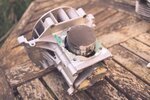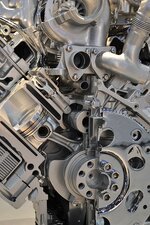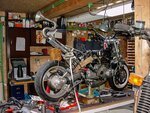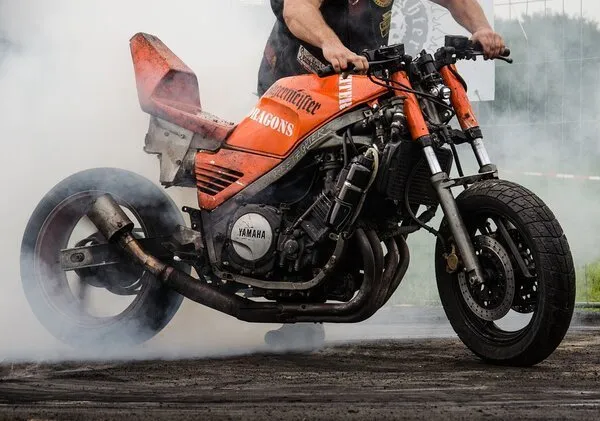How does the motorcycle engine seize? Engine seizures occur when the many mechanical parts that make up your engine get stuck.
And the cause? Improper or a complete lack of lubrication. Think of it: how many of us know how often we should change our oil, or even how to? But that’s not the only cause. Rust, overheating, and even underuse can result in an engine seizing up.
So, how do you fix a seized engine? Is it even possible? We tackle the question head-on and show you how to free up your engine.
How Do You Know If Your Motorcycle Engine Is Seized?

How do you know if your engine is seized? Here’s how you can tell:
- Your engine does not move. Although a completely seized engine won’t move at all, a partially seized engine or one that’s starting to seize will move somewhat.
- The engine produces loud knocking sounds when you try to crank it. A horde of problems could cause this, including the starter striking your flywheel.
- You can hear faint knocking/tapping sounds from the motor. This indicates that your engine is in the initial stages of seizing. And if you do not fix the problem, it may lead to complete engine failure.
Is It Worth Repairing A Seized Bike Engine?

No one likes to hear the bad news of an engine seizure. But you can’t keep on avoiding the situation.
First things first, can you repair a seized engine? The short answer is yes, but it will cost a lot. Depending on where you get the repair done, you could be looking at up to 8 grants of repair costs. And that alone is enough to dissuade people.
But you can do some handy repairs yourself at about half the price. That is if you know how to fix a seized engine. However, even if it costs 8 grand, it’s much better than buying a new bike or engine.
How Does the Motorcycle Engine Seize?
There are a few causes that can lead to engine seizure, including:
Lack of Lubrication:
One of the most common causes of motorcycle engines seizing is lack of lubrication. Since seizing is due to your engine’s moving parts getting stuck, proper lubrication will help against the problem. Failing to add oil in a timely manner could result in permanent damage.
Wear isn’t effortless to fix. You’ll most likely need to replace the parts that have worn out. Plus, the excess heat and friction can reduce your engine’s performance and affect gas mileage.
Old or Dirty Oil:

So, you’re thinking, “Okay, I regularly change the engine oil, so I’m safe.” But low engine oil isn’t the only problem. Many folks who are punctual in oil changes may use bad or dirty oil. Not all oil is the same, after all.
If you’re topping off the oil that is quite old but unused, you could be putting your engine at risk for a seizure. It doesn’t take long for the dirty oil to lose its lubricating prosperities.
You may also want to change up oil brands. Each oil has a different lifespan. And it could be that yours is just too thin and doesn’t lubricate the components well.
Rust and Grime Built-up in The Engine:
Grime and rust are just as culpable as engine oil. In particular, motorcycles that have been abandoned for years, or even months, are sure to seize.
But how does the motorcycle engine seize when it’s not in use? You see, when your bike is no longer in use, the components inside the engine stop moving. And that opens up a whole new gateway for rust and grime to get in between the crevices.
Once rust has formed between the engine’s parts, simply running the engine or changing the oil won’t suffice.
And that’s not even the first part. Rust is formed fromthe metal parts, which means your pistons will fuse with the cylinder and refuse to budge.
Driving Conditions:
Too much of everything is terrible. Driving too often (and frequently, too fast) will lead to engine wear.
Your lubricant can only handle so much friction and heat. Overworking the engine will mean that your pistons are producing more friction and hence more heat. This means they’re wearing out faster than your lubricant can protect you.
Lack of Regular Motorcycle Service:

Finally, lack of regular motorcycle maintenance. Now, this ties in with our first point of lack of lubrication. But engine oil isn’t the only thing that contributes to engine seizure.
Lack of proper maintenance will eventually lead to your engine seizing up. And there are a lot of things to blame for this.
How to Free a Seized Motorcycle Engine – Step by Step:
Step 1: Preparations

First things first, make sure your bike is cooled down, and the engine hasn’t been in use recently. Trying to crank up a seized engine usually produces a lot of heat.
Start by removing the spark plug using the appropriate spark plug wrench. If you notice any dirt around the spark plug, clean it as well.
Step 2: Oil Up Your Spark Plug
Now that you’ve removed the spark plug, apply a bit of the penetrating oil into the spark plug hole. If you know anything about how motorcycles work, you’ll know that the spark plug is the best way to access the pistons. Lubricating the spark plug hole essentially means oiling up the pistons.
This should help dissolve any grime or even rust that may have accumulated between the piston and the corresponding cylinder. To be safe, let the solution sit for over an hour.
Step 3: Try to Start Your Engine
After waiting an hour, it’s safe to try to start your engine again. Check if the knocking sound is still present or if the engine is completely seized up.
But even if your engine fails this time, there’s still hope. Let the oil sit overnight, see if the machine works, then move on to the next step.
Step 4: Open the Crankcase

If accessing the pistons doesn’t work, then you’ll need to get your hands dirty. Start by opening the engine’s crankcase. It’s not in my right to tell you how to do that. Check out internet forums or look at the bike’s service manual, as the procedure is specific to year and model.
Step 5: Wipe Off Dust and Grime
Now that you’ve opened up the crankcase check for any grime. If the situation is terrible, you’ll see some right off the bat. But if the problem is terrible, most of it will be stuck in the crevices, out of sight. Check with a flashlight for any grime hiding between nooks and evaluate how dirty the engine is.
Dampen your terry-cloth rag with motor oil and use it to clean the grime. It should not only lubricate the engine better but also dissolve any visible dirt.
For any flaking rust that cannot be dissolved, use your blunt instrument. Once you’re done, pour a generous amount of penetrating oil on top of the piston. Let it sit for up to 15 minutes before continuing.
Step 6: Help the Solution Penetrate
Now, you need to help the oil penetrate. For this, you’ll need to guide the oil through the apertures using a copper wire.
Pull out your copper wire and cut off a one-foot piece of it. Then use your hammer to flatten one end.
Slide your copper wire between the cylinder wall and the piston by passing it flat end-first. Gently work the wire around the entire cylinder wall.
Step 7: Give It a Test Run
And you’re mostly done. The last thing you need to do is give the bike a test run. Before that, use any suitable wrench to free up the crankshaft bolt. This will connect your engine back to your bike. Now, give it a test run.
In most cases, the engine will, at the very least, startup. If not, consider either buying a new engine or contacting a professional.
How to Prevent Seizing:
Preventing seizing is simple. Here’s how you can protect your engine from seizing:
1. Regularly Change the Engine Oil:

The engine oil is the essential component on a bike, especially for mitigating the risk of a seizure.
Most bikes have a pre-defined oil change “interval” (the traveled distance you should change the oil). Find that out and change your bike’s oil on or before that interval.
2. Try A Different Brand:
Sometimes, it’s the brand of the oil that could cause problems. Perhaps the formula allows for more rust and corrosion. Or maybe it easily evaporates or loses its oily properties. Other oils may heat themselves in the engine, which is no better.
Consider switching oils, even if you’re using a well-known brand. Sometimes the oil may not be the right one for your bike, even if it’s from a reliable manufacturer.
3. Regularly Service the Engine:

While giving your bike a cautionary run each time is essential, rust can still form. You should open up the crankcase and give it a clean twice a year. The number can go up or down depending on how well you’ve maintained the engine.
4. Don’t Overwork Your Bike:
Stop revving your engine so much. It’s not helping anyone and may lead to permanent engine failure. Yes, a few fast-paced rides are allowed. But if you’re always running your bike at full speed, and that too every day or so, you’ll need to cut it down a bit.
5. Don’t Abandon Your Bike:
Overworking your bike can lead to engine seizure, but an idle bike will produce the same problem. If you have a bike that you haven’t used in a while, you should take it out for a short ride. Even if you’re going around the corner, you’ll be surprised to know just how much your engine needs it.
FAQ
What does a seized motorcycle engine sound like?
A seized engine will sound like what the professionals call a “death knock.” It will sound like a loud clunking/knocking sound that doesn’t sound metallic. If your engine is partially seized, you may still hear a faint knocking sound every time you crank it up.
Can you fix a seized engine motorcycle?
Yes. You can fix a seized engine by lubricating it and cleaning the engine of rust and grime. Note that not every case of engine seizure is curable by amateur garage work.
How much does it cost to unseized an engine?
It depends on how complex the situation is. At best, you’ll be charged a few hundred bucks for cleaning the engine. At worst, however, you could be looking at up to $8,000 in expenses if your engine needs rebuilding.
How long does it take for an engine to seize without oil?
The exact number is anyone’s guess, but estimates put it somewhere at 30 minutes. That number is nothing compared to how long you usually ride your motorcycle. Don’t take your chances and oil up our engine straightaway.
Can you use WD-40 as engine oil?
It is not recommended to use WD-40 as engine oil. Instead, it can be used as a penetrating oil, meant to free up parts that have gotten stuck together. It may work under particular circumstances, but it’s best not to take your chances.
Can an engine get seized from overheating?
An engine has a lot of metal parts. And while they are quite thermally stable, they have a limit. How does the motorcycle engine seize from overheating? Overheating will eventually warp the engine and lead to seizing and failure. Your lubricant could also evaporate or lose its consistency.
Does oil go bad sitting in an engine?
Oil, much like any other liquid, will gradually degrade in viscosity over time. However, this process will occur regardless of whether your engine is running or not. Change the oil frequently, even on a running bike.
What happens if you go too long without an oil change?
Waiting too long to change the oil will lead to complete engine failure. Your engine will get seized. And the damage could be more permanent depending on how badly it’s been seized.
How long can you go without an oil change?
The oil change interval depends on the vehicle, the oil, and a lot of other factors. Look up the manufacturer’s recommendations for changing the oil, both of the vehicle and the oil. As a precautionary measure, open up your engine to check if it has any rust at least twice a year.
Conclusion
Engine seizure is quite terrifying. And many people think it happens out of the blue. But sure enough, there are ways you can predict engine failure. And as such, there are ways to prevent and cure it too.
How does the motorcycle engine seize? Due to a lack of proper lubrication. You can avoid this through regular oil changes and switching to a more reliable brand.
But if your engine is seized, chances are the damage is irreversible. And you might have to spend a few grants to repair or replace it.
So, don’t bet on it; listen to your engine, and keep your motorcycle safe!


